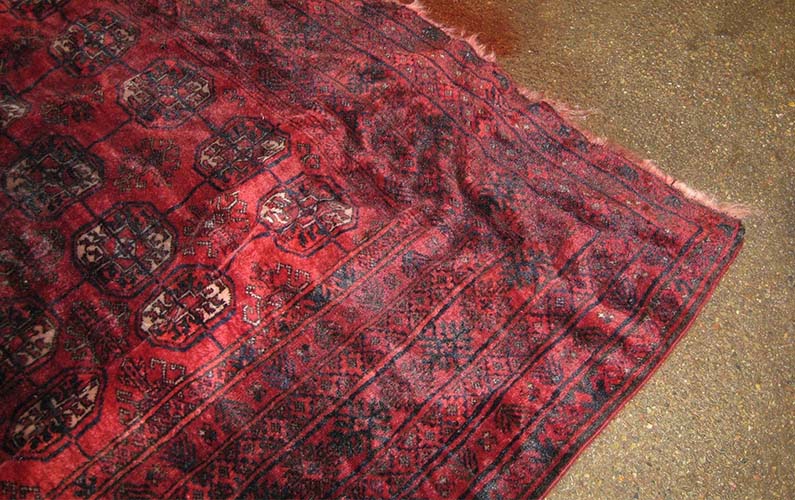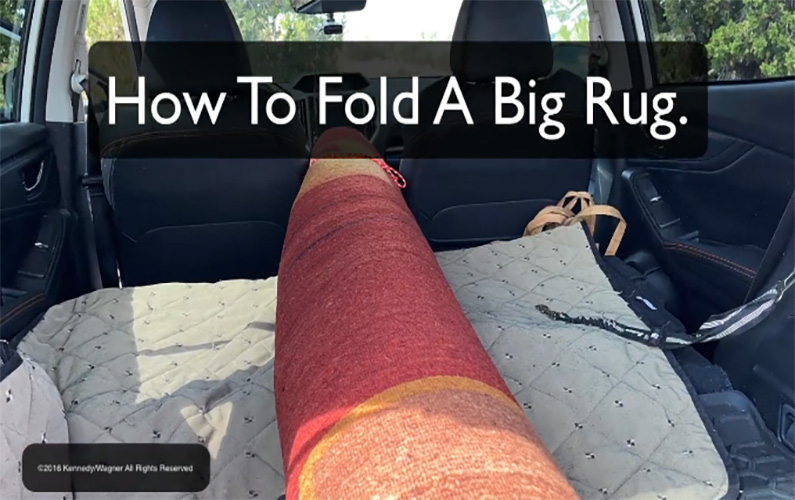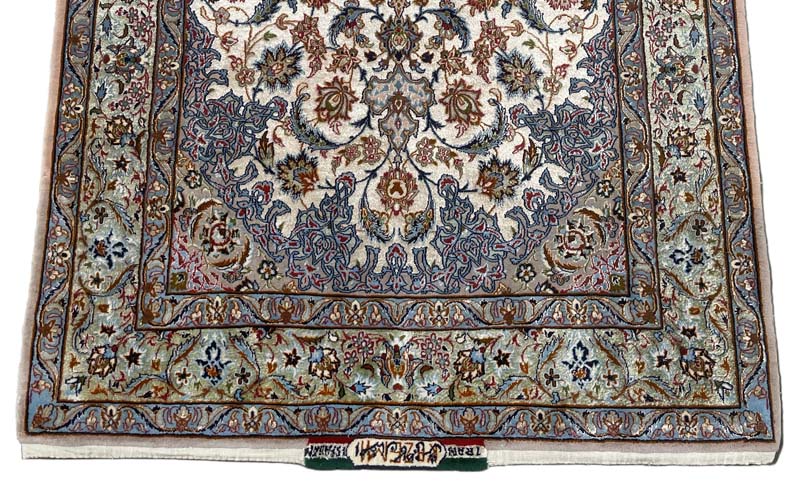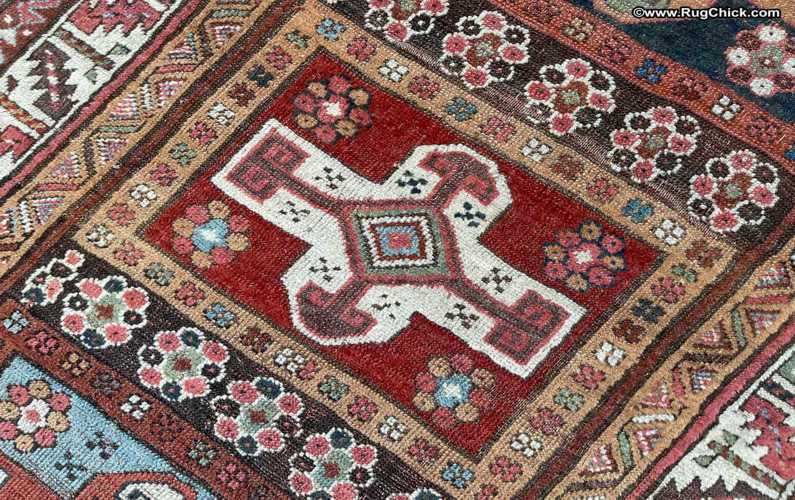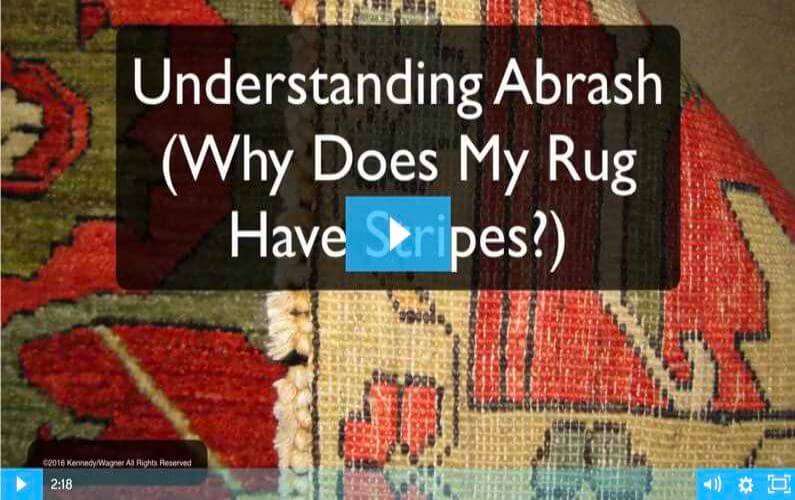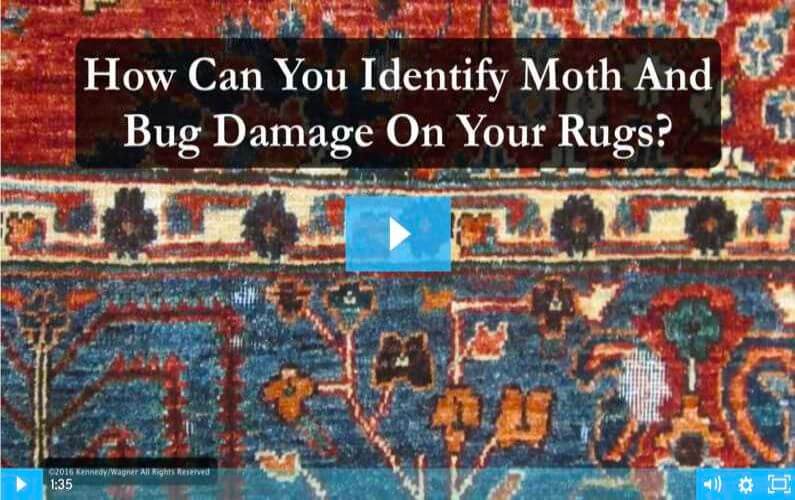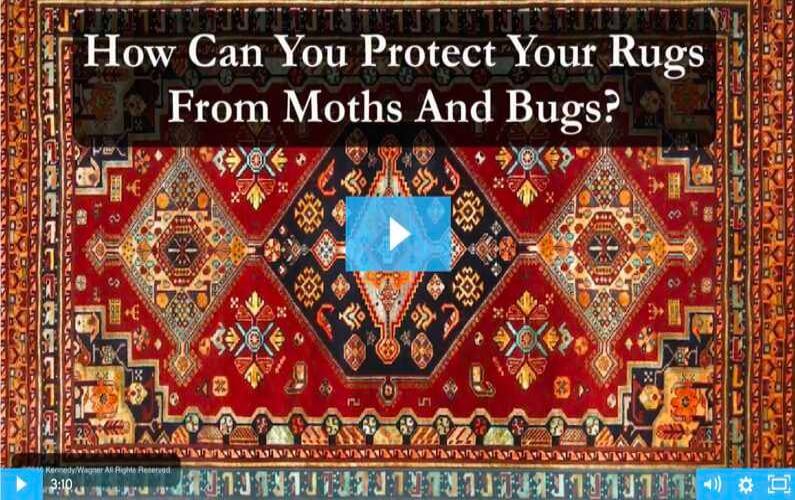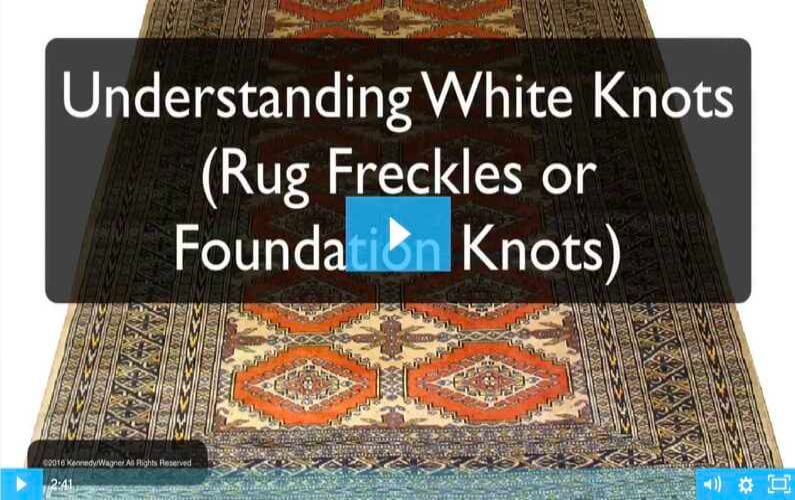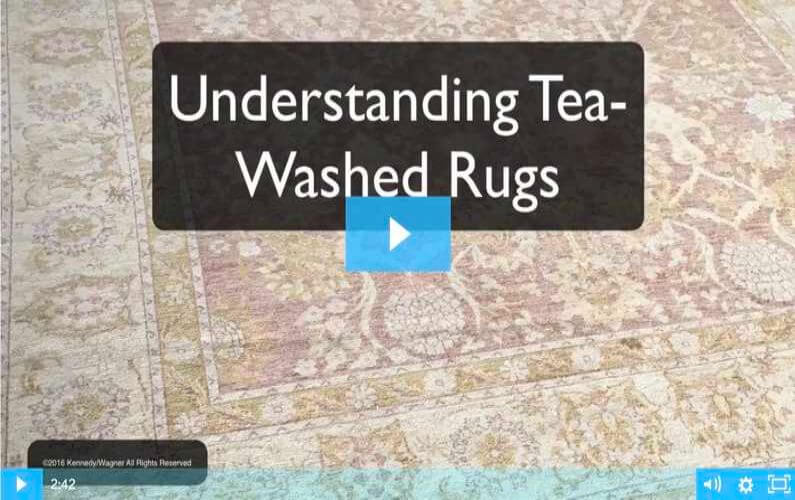Hooked Rugs. Some Things To Watch For.
If you’ve ever done a little bit of needlepoint or other embroidery, you can envision the craft of latch hooking a rug also. They all fall into the same “family” of construction type.
For a great video on the literal 1-2-3 of crafting a hooked rug, this is a great one:
Hooked rugs are fun. They can have WHIMSICAL DESIGNS

Or a small simple FLORAL DESIGN

It could be ABSTRACT DESIGN
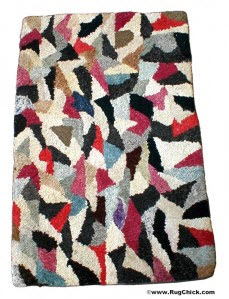
Or it could be a classic floral design like this large hooked rug from China with a French Aubusson floral motif:

Look at the even and fine loops in this construction – these rugs hold up very well under regular use, and they wash up great:

Here’s the corner.

These older hooked rugs from China do NOT have the latex on the back that many of the new hooked product (the larger sizes) do today. These are the really well made ones, the ones where you can SEE the loops on the back side instead of a material backing. The material tends to be hiding latex, which is an adhesive used to “hold” the loops in place when they are not woven in place tightly.
Every rug making country, and every rug construction type (woven, tufted/hooked, custom), has both low quality and high quality examples.
I’m often asked “what country has the best rugs?” And the answer is, they all do…
…and they also have the worst! LOL. You just need to know what you are looking for.
So in regards to specifically “hooked rugs” – I want to point out a few dangers to be on the lookout for so that you do not purchase a rug that may have problems the untrained eye may not see when purchasing as an investment… or to simply use and enjoy in your home.
Hooked Rug Buying Tips
1. The FIBERS
Unless you plan to use the rug as a doormat and will abuse it and so are looking for the cheapest quality rug possible (which you can find PLENTY at your local Home Improvement Box Store) – I tell people that they want to find a WOOL rug.
Why wool? Lots of reasons. It’s strong, comes in a wide variety of colors, has great texture, and not being “synthetic” is not made of petroleum by-products.
Here’s a post I did on all of the advantages of wool => Why Wool Rugs Rule!
Wool hooked rugs will tend to be woven on a cotton mesh foundation. Cotton is strong, and holds its shape well. There are also cotton-on-cotton hooked rug (cotton face fibers looped around a cotton foundation mesh), but one of the drawbacks of these are that cotton is VERY absorbent and will show soil faster than wool, so it looks ugly faster. So I prefer a wool hooked rug on a cotton foundation mesh.
New product should have a tag on it that tells you what fibers are being used in the rug. The synthetic knock-off of wool is acrylic, which is a horrible substitute (if you’ve ever worn an acrylic sweater you know what I’m talking about, flat colors, ages and loses vibrancy quicker, and has the look of a “sponge” – no sheen, texture, or patina of good wool.)
2. The DYES
You need to test the dyes to see if they are colorfast. One quick way to avoid the WORST dyes when you are shopping, is to take a handkerchief with you, get it damp and rub the stronger colors in the piece (not too aggressively – you don’t want to “fuzz” it up).
If the dye transfers onto the handkerchief when it’s DRY, then you have a problem rug on your hands. This type of transfer is called “crocking” – and this means one of two things, either the fibers were not properly washed after dyeing, and there is “excess” dye in the fibers that will bleed out when wet (with spills or even proper washing), or the rug has been “touched up” with additional dye (sometimes INK) to make it artificially brighter for sale.
Think of this as the same thing some sellers of produce do with fruit – dyeing them to make them look more appetizing than they really are. And it’s covering up usually a less than quality product, so it’s a sign of a “cover up.”
When they use ink as a cover up for a rug, it’s a sign of a disaster in waiting because ink will NOT be able to be removed after it bleeds out, whether on the rug itself, or when it gets on your carpeting if you have the rug over your wall-to-wall carpet.
You also want to take a look INSIDE the fibers, at the base of the loops, to see if there is by chance some “stenciling” that has taken place. This is when some manufacturers use INK to sketch out the design they are creating. The lesser quality weaves use obnoxiously bright pink and blue ink to map out their designs, and this often bleeds out when wet.
You see, professional rug cleaners can stabilize DYES for cleaning a rug, but you cannot stabilize INK. And if they have not used a permanent ink (which these pink/blue inks tend to not be permanent) – then it wicks out when you spill on it or have the rug washed properly.

Here’s a rooster hooked rug that has bled pink in several areas:
Pink ink stenciling has bled out on this hooked rug
This type of problem is a sign of inferior workmanship, and is a manufacturing flaw.
Rugs are meant to be washed to clean them – that is the recommended method of cleaning for especially wool rugs. So with stenciling in this manner, they are creating a situation where the rug cannot be properly cleaned without creating a disaster – so it’s a flaw.
If you are looking to buy a hooked rug, grin open the fibers to see if there is any ink at the base of the loops – like I show down below.


If you already own a hooked rug that has this stenciling you have two options: 1) return the rug and ask for another without the stenciling, or 2) be sure to use a rug professional who handles many rugs, and sometimes they have ways to wash and help move the ink to the back side of the rug instead of coming to the top side like this rug did below when it was cleaned by someone who was not aware of the danger lurking beneath the loops.

3. The BACKING MATERIALS
As I mentioned before, the best hooked rugs are well constructed and do not need the additional latex and material backing to hold it together, so you can see the loops on the back side and the rug is very pliable and flexible. It takes more time to weave a hooked rug this way, so these will tend to be a bit higher price – but it will last you longer.
Here is one with a material backing but NO latex. It’s not my choice of design (LOL!) – but it is an example of a very well made hooked construction rug. This will last a long time:

Here is one with a material backing but NO latex. It’s not my choice of design (LOL!) – but it is an example of a very well made hooked construction rug. This will last a long time:

Many though have a mesh and latex backing, usually covered up with a cotton or muslin cloth to cover up this type of latex ugliness:
Another problem on some backing materials used are that the adhesive can have fillers in it that crumbles and “powders” with age. If you can *smack* the back corner of your rug, and you see a little *POOF* of powder, then you see this problem. I’ve seen this on even some of the very expensive hooked rugs being woven today.
What the *POOF* powder test simply means is that when the rug is washed, this is going to crumble away. And what is typically needed then is that the muslin or linen backing is pulled off, the powder is vacuumed away (by your professional rug cleaning company), and a fresh layer of a higher quality latex is applied.
It’s a standard repair, and will only need to be done once.
I’m not exactly sure why this powdering problem is happening with the newest hooked rugs these days from the U.S. and China, because they tend to be well made products, so perhaps they do not know that their adhesive quality is not up to par.
Regardless, this is just something to be aware of, that the first cleaning will also require a repair if you notice this issue. The backing type usually looks much cleaner and whiter than the prior “yellow” latex backing photo, like this:

These are the type that may have the “powdering” problem. Try the whack-and-poof test on them to know for sure. =)
Sometimes in inspecting the backing you can see stenciling “peeking” through. Always inspect the front and back of the rug to look for warning signs when you are shopping for rugs.

You also want to look for edges on the back that are peeling away, or any crumbling that may be happening with the latex. You also want to see if you nothing any ODOR from the latex. Sometimes a poorer quality latex will have a strong odor that gets worse with time.
Give it the sniff test.
4. The STRUCTURAL quality
If you are looking at early 20th century American hooked rugs (pre-World War II), there is a chance that they are woven on a jute foundation instead of cotton like most of today’s rugs are. Though some contemporary rugs from Portugal are still woven on jute. Check the tag.
The problem with jute is that over time it literally disintegrates. It rots over time (or accelerated by improper long term water exposure). This Spanish rug is splitting apart from the inside out:

With rugs that may have an older jute foundation, or any dry rot in a cotton foundation, or a rug with delaminating latex – you can FEEL it in the construction. When you go to roll it, if you squeeze a bit on the back you can feel a *cracking* and can hear it. It is a snap, crackle, pop sound.
When this happens – it’s a BIG warning sign. And if it is dry rot, it is not reversible or correctible. It’s as if your skeleton were to crumble – the foundation structure of the rug is literally disintegrating from the inside out.
So check for that.
You also want to check the structural quality of the hooking process itself.
If you can easily *tug* a loop and it pulls free, then you may have a rug on your hands that a shoe heel, a vacuum cleaner, or a puppy may unravel like magic right before your very eyes.
Here’s a hooked rug that was a chew toy for a puppy for just a few minutes. We fixed it, but it may not be the last time we see it for a repair.

It is possible to repair these, as you can see Hooked Rug vs. Puppy
But it is best to have a hooked rug that is tough to pull loose and apart. Then you will have fewer problems down the road, and will enjoy your rug without having to worry about babying it.
So – there are the tips for you if you are looking to by a hooked rug. Hope they help keep you out of trouble, and happy rug shopping!

